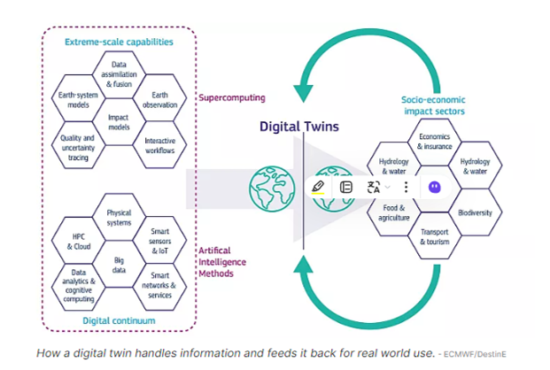A digital twin is a digital model of something real. It is indistinguishable from reality and duplicates the real world for testing and providing feedback. Now scientists backed by the European Commission with a €315 million budget are building Destination Earth (DestinE), a digital twin of the planet for testing climate and weather predictions and policies.
Margrethe Vestager is the Executive Vice-President of Europe Fit for the Digital Age. She describes DestinE as “a true game changer in our fight against climate change…It means that we can observe environmental challenges can help us predict future scenarios like we have never done before…Today, the future is literally at our fingertips.”
A digital twin is not a simulation. That’s because it will adapt over time to the changes occurring in the real world. Having written a posting last year where I described what it was like to fly the Lunar Excursion Module simulator at a museum in Neil Armstrong’s hometown, if allowed to work with DestinE the difference would be immediately noticeable. A digital twin constantly receives real-world inputs changing its responses and learning from humans providing inputs and operating it.
My simulator experience shows a distinct difference. When I flew the LEM simulator the programming didn’t adapt to me other than responding in a fixed way to my use of the controllers in the cockpit. Its logic never changed. It didn’t learn anything from me. Instead, I used trial and error to master the landing and failed every time.
In comparing digital twins to simulators, the former a 2021 European Union study concluded uses less horsepower to operate. DesinE will operate on one supercomputer with 20,000 graphic processors installed and consume 20 Megawatts of electricity. The computer is the EuroHPC supercomputer which is located in Finland where the energy it consumes will be supplied from renewable sources.
DestinE features a Digital Twin Engine, an innovative software architecture composed of a Core Service Platform and Data Lake. What is a data lake? It is a centralized repository for storing raw, unstructured, and semi-structured data in native formats. It is described as the single source of truth for all data, regardless of type or source.
DestinE will use artificial intelligence (AI) machine learning models and allow users to feed it data and questions to see the results on the digital twin. It will answer “what-if” questions at the macro and micro level. The priority is to tackle Weather-induced Extremes and Climate Change Adaptation (Climate DT) and determine scenario and policy impacts fed to it at a global, continental and local scale looking several decades ahead.
DestinE is the first supernational effort to operationalize a digital twin of Earth looking at multi-decadal climate projections and assessments down to areas the size of a few square kilometres where most impacts of climate change are observed. Hypothetical scenarios played out on it will help policymakers determine where to build wind and solar farms and what crops to plant as real climate changes occur. DestinE will help governments respond to natural disasters and assess potential socioeconomic and policy impacts before the real thing happens.
States Peter Bauer, co-initiator of Project Destination Earth, “If you are planning a two-metre high dike in The Netherlands, for example, I can run through the data in my digital twin and check whether the dike will in all likelihood still protect against expected extreme events in 2050.”
DestinE’s software is open-source and being co-developed by members of the European Union community. It is designed to adapt and evolve to address real-world changes. Although the project’s completion date is 2030, users will be able to begin working with parts of the digital twin Earth as early as 2027.









